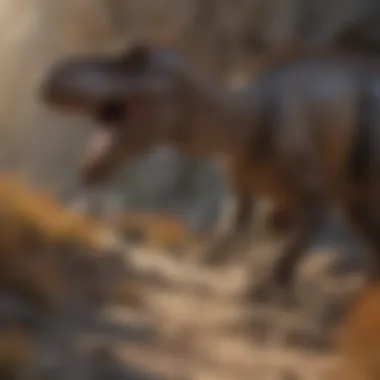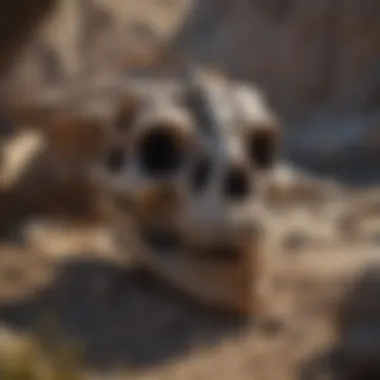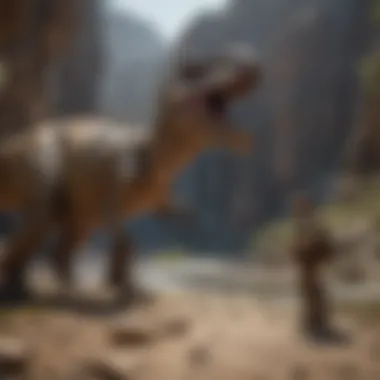Unraveling the Enigmatic Hell Creek Dinosaurs: A Dive into Prehistoric Wonders


Rock and Fossil Identification
Delving into the realm of Hell Creek dinosaurs necessitates a keen understanding of rock and fossil identification. This segment explores the various types of rocks and fossils synonymous with this intriguing era. One must be vigilant in recognizing the key characteristics indicative of these ancient specimens. Tools play a pivotal role in this identification process, aiding enthusiasts and researchers in distinguishing the fossils and rocks that emerge from the depths of time.
Collecting Tips and Techniques
When embarking on the journey of collecting Hell Creek fossils, it is imperative to adhere to best practices. Locating prime collecting sites requires meticulous research and a sharp eye for geological nuances. Safely extracting specimens from their resting places demands finesse and care to ensure their integrity remains intact throughout the process of retrieval.
Preservation and Display
The art of preserving Hell Creek rocks and fossils embodies a delicate balance between science and creativity. Various techniques are utilized to halt the relentless march of time, securing these invaluable pieces of history for future generations. Knowing the proper storage methods is paramount to maintaining the integrity of each specimen. When it comes to display, creativity knows no bounds, allowing enthusiasts to showcase these treasures in a visually captivating manner.
Geological Insights
Introduction to Hell Creek Dinosaurs
Hell Creek Dinosaurs are an intriguing subject in the realm of paleontology. Delving into the depths of time, these ancient creatures provide a window into a bygone era, offering valuable insights into the evolution of life on Earth. By exploring Hell Creek Dinosaurs, we uncover not just fossils but a piece of the intricate puzzle that is our planet's history. This section serves as a gateway to understanding the significance of these prehistoric beings, setting the stage for a journey through time and evolution.
Formation of Hell Creek Formation
Ancient Environment
The ancient environment of the Hell Creek Formation lays the foundation for understanding the world these dinosaurs inhabited. This primordial landscape, characterized by lush forests and meandering rivers, provides a snapshot of a time long past. The unique juxtaposition of flora and fauna in this environment paints a vivid picture of the ecosystems that shaped the evolution of dinosaurs. Despite the challenges of deciphering ancient landscapes, the richness of the Hell Creek Formation offers a valuable resource for paleontologists seeking to piece together the puzzle of prehistoric life.
Sedimentary Layers
The sedimentary layers within the Hell Creek Formation hold the key to unlocking the secrets of the past. These stratigraphic records offer a detailed chronicle of environmental changes and depositional processes that occurred over millions of years. By studying these layers, scientists can unravel the history of geological events and the dynamics of past ecosystems. The intricate details preserved within the sedimentary structure provide a wealth of information for reconstructing the ancient world, allowing us to peer back in time and witness the majesty of Hell Creek's distant past.


Fossil Preservation
The meticulous preservation of fossils within the Hell Creek Formation offers a rare glimpse into the lives of dinosaurs. The exceptional quality of preservation found in this geological site provides scientists with a wealth of data, from skeletal remains to traces of behavior. By analyzing these well-preserved fossils, researchers can piece together the intricate details of dinosaur biology and ecology, shedding light on their behaviors, habitats, and evolutionary adaptations. The fossil preservation in Hell Creek stands as a testament to the fragility of time, capturing moments that have endured for eons.
Significance of Hell Creek Dinosaurs
Contribution to Paleontology
The Hell Creek Dinosaurs have made substantial contributions to the field of paleontology, revolutionizing our understanding of prehistoric life. Through the study of these iconic creatures, researchers have unraveled evolutionary patterns, biological adaptations, and ecological interactions that have shaped the world we know today. The abundance of fossil remains in Hell Creek has provided scientists with a treasure trove of information, fueling centuries of research and discovery in the field of paleontology.
Impact on Evolutionary Studies
The Hell Creek Dinosaurs serve as pivotal subjects in evolutionary studies, offering a glimpse into the mechanisms of adaptation and speciation. By studying the anatomical features and genetic variations of these ancient beasts, scientists can trace the evolutionary trajectories that led to the diversity of life on Earth. The discoveries made in Hell Creek have illuminated the pathways of evolution, highlighting the interconnectedness of species and the forces that drive biological change over time.
Key Discoveries
The ongoing excavations in Hell Creek continue to unearth key discoveries that shape our understanding of prehistory. From new species to behavioral insights, each fossil find adds another piece to the evolutionary puzzle. These key discoveries not only expand our knowledge of past ecosystems but also inspire new avenues of research and inquiry. The significance of these findings reverberates through scientific communities, sparking debates, collaborations, and future exploration into the mysteries of Hell Creek.
Types of Hell Creek Dinosaurs
Triceratops
The formidable Triceratops roamed the ancient plains of Hell Creek, leaving behind a legacy of strength and resilience. This iconic herbivore, known for its distinctive frill and three horns, represents a pinnacle of dinosaur diversity. The study of Triceratops provides valuable insights into herbivorous adaptations, social behaviors, and ecological niches that shaped the evolution of horned dinosaurs.
Tyrannosaurus rex ####Enthralling the imagination with its ferocious presence, the Tyrannosaurus rex stands as a towering figure in the annals of paleontology. With its massive jaws, serrated teeth, and powerful hind limbs, this apex predator ruled the Cretaceous landscapes of Hell Creek. The exploration of Tyrannosaurus rex delves into predator-prey dynamics, locomotion mechanics, and evolutionary success strategies that defined the fate of this fearsome carnivore.
Anatosaurus ####The Anatosaurus, also known as Anatotitan, roamed the ancient floodplains of Hell Creek as a colossal herbivore. With its long neck, broad beak-like mouth, and massive body, this giant duck-billed dinosaur represents a distinctive herbivorous lineage in the Late Cretaceous. By studying the anatomy and behavior of Anatosaurus, researchers gain insights into herbivorous adaptations, migration patterns, and ecosystem interactions that characterized the diverse fauna of Hell Creek.


Scientific Research and Findings
In the realm of Hell Creek dinosaurs, scientific research and findings play a pivotal role in unraveling the mysteries of these ancient creatures. Through meticulous paleontological studies, researchers delve deep into the fossil record to extract invaluable insights into the lives of these prehistoric beings. Fossil analysis serves as a cornerstone of this research, offering a window into the past through the examination of skeletal remains. Behavioral insights provide a fascinating glimpse into the behaviors and interactions of Hell Creek dinosaurs, shedding light on their social structures and survival strategies. Additionally, studying their feeding habits unveils crucial information about their ecological roles and dietary preferences, painting a comprehensive picture of their place within the ancient ecosystem.
Paleontological Studies
Fossil Analysis
Fossil analysis stands as a fundamental aspect of paleontological studies concerning Hell Creek dinosaurs. By scrutinizing the intricate details preserved in fossils, researchers can reconstruct the anatomical features and evolutionary trajectories of these ancient creatures. The meticulous examination of bone structures, teeth patterns, and fossilized remains forms the bedrock of understanding the biology and physiology of Hell Creek dinosaurs. Despite its challenges, including issues of fossil preservation and fragmentary specimens, fossil analysis remains a powerful tool for piecing together the puzzle of prehistoric life.
Behavioral Insights
Delving into behavioral insights offers a unique perspective on the lives of Hell Creek dinosaurs. By studying trackways, nest sites, and coprolites, researchers can glean information on their locomotion, nesting behaviors, and dietary habits. This behavioral data provides valuable clues about their social dynamics, migratory patterns, and adaptation strategies to environmental changes. While interpretations may vary and pose challenges in reconstructing precise behaviors, behavioral insights add depth to our understanding of the behavioral ecology of these ancient reptiles.
Feeding Habits
Exploring the feeding habits of Hell Creek dinosaurs sheds light on their role within the ecosystem. By analyzing tooth wear patterns, stomach contents, and feeding traces, researchers can infer their dietary preferences and foraging behaviors. Understanding their feeding habits elucidates their ecological impact, trophic interactions, and potential competition with other species. Despite limitations in interpreting dietary adaptations solely from fossil evidence, investigations into feeding habits provide crucial insights into the dietary ecology of Hell Creek dinosaurs.
Exploring the Legacy of Hell Creek Dinosaurs
In this section, we delve into the enduring significance of uncovering the legacy left behind by the enigmatic Hell Creek dinosaurs. By examining the fossils and remnants of these ancient creatures, we gain invaluable insights into the prehistoric ecosystem. Understanding the behaviors, interactions, and adaptations of species like the Triceratops, Tyrannosaurus rex, and Anatosaurus paints a vivid picture of life millions of years ago.
Educational Outreach
Museums and Exhibits
Exploring museums and exhibits dedicated to Hell Creek dinosaurs is a pivotal aspect of educational outreach. These institutions not only showcase impressive fossil collections but also provide interactive experiences that bring these creatures back to life for visitors. The key characteristic of museums and exhibits lies in their ability to bridge the gap between past and present, allowing individuals to witness the wonder of paleontology up close. The unique feature of these displays is their role in promoting scientific literacy and inspiring the next generation of researchers and enthusiasts.


Public Awareness Campaigns
Public awareness campaigns play a crucial role in disseminating knowledge about Hell Creek dinosaurs to a wider audience. By utilizing various media platforms and events, these campaigns raise awareness about the importance of paleontological research and conservation efforts. The key characteristic of such initiatives is their ability to engage people of all ages and educate them on the significance of preserving our natural history. However, a potential disadvantage could be oversimplification or sensationalism, which may lead to misconceptions.
Virtual Learning Tools
The digital age has enabled the development of virtual learning tools that bring Hell Creek dinosaurs into classrooms and living rooms worldwide. These tools offer interactive experiences, 3D models, and simulations that enhance understanding and engagement. The key characteristic of virtual learning tools is their accessibility, allowing individuals to explore paleontological concepts regardless of their location. A unique feature is the immersive nature of these tools, which can recreate ancient landscapes and make learning a truly interactive experience.
Conservation Efforts
Preservation of Fossil Sites
Preserving fossil sites is paramount in safeguarding the history and heritage of Hell Creek dinosaurs for future generations. By protecting these sites from looting and environmental degradation, we ensure that invaluable scientific data is not lost. The key characteristic of fossil site preservation is its role in maintaining the integrity of specimens and ecological contexts. The unique feature lies in the collaborative efforts required to balance scientific research with site protection, a delicate but essential task.
Environmental Advocacy
Environmental advocacy focuses on broader conservation issues related to the habitat and ecosystems that once hosted Hell Creek dinosaurs. By advocating for sustainable practices and habitat preservation, activists aim to protect not just the fossils but also the living species that share these environments. The key characteristic of environmental advocacy is its long-term vision and dedication to promoting a harmonious relationship between humans and nature. One challenge could be the complex nature of environmental issues, requiring multifaceted solutions.
Legislative Measures
Implementing legislative measures is essential in establishing protections and regulations for Hell Creek dinosaur fossils and their habitats. By enacting laws and policies, governments can ensure that these valuable resources are preserved and managed responsibly. The key characteristic of legislative measures is their legally binding nature, providing a framework for enforcement and accountability. However, challenges may arise in balancing conservation priorities with economic interests and public access.
Future Prospects
Technological Advancements
Technological advancements are revolutionizing the field of paleontology, offering new tools and methodologies for studying Hell Creek dinosaurs. From high-resolution imaging techniques to genetic analysis, these advancements enable researchers to uncover unprecedented details about prehistoric life. The key characteristic of technological advancements is their ability to push the boundaries of scientific knowledge and redefine our understanding of ancient ecosystems. One limitation could be the cost and technical expertise required to utilize these cutting-edge technologies.
Upcoming Research Initiatives
Upcoming research initiatives promise to unravel even more mysteries surrounding Hell Creek dinosaurs, with scientists embarking on ambitious projects to delve deeper into the past. By exploring uncharted territories and applying innovative research techniques, these initiatives seek to expand our knowledge base and challenge existing hypotheses. The key characteristic of such initiatives is their collaborative nature, bringing together experts from various disciplines to tackle complex questions. However, funding and logistical constraints may pose challenges to the execution of large-scale research.
Collaborative Projects
Collaborative projects among institutions, researchers, and enthusiasts are driving forward our understanding of Hell Creek dinosaurs. By pooling resources, expertise, and data, these projects facilitate interdisciplinary investigations that are crucial in piecing together the puzzle of prehistoric life. The key characteristic of collaborative projects is their capacity to generate synergy and foster innovation by leveraging diverse perspectives and skills. Nonetheless, coordinating multiple stakeholders and aligning goals can present organizational hurdles.







